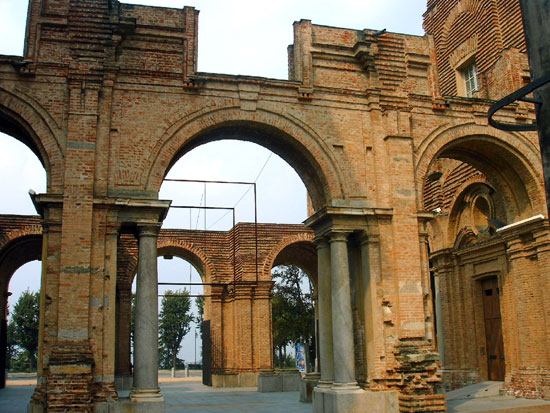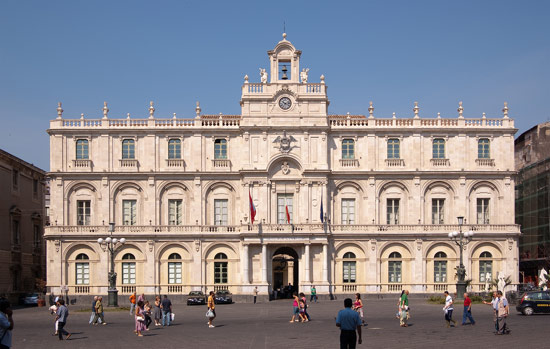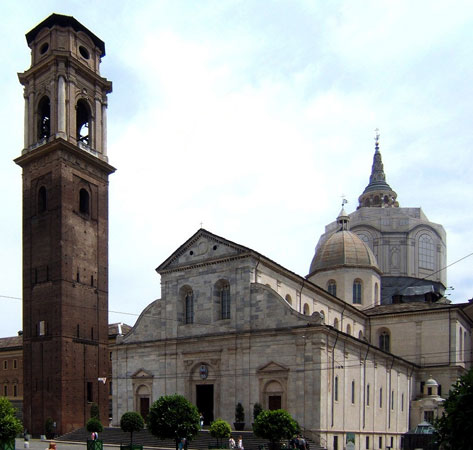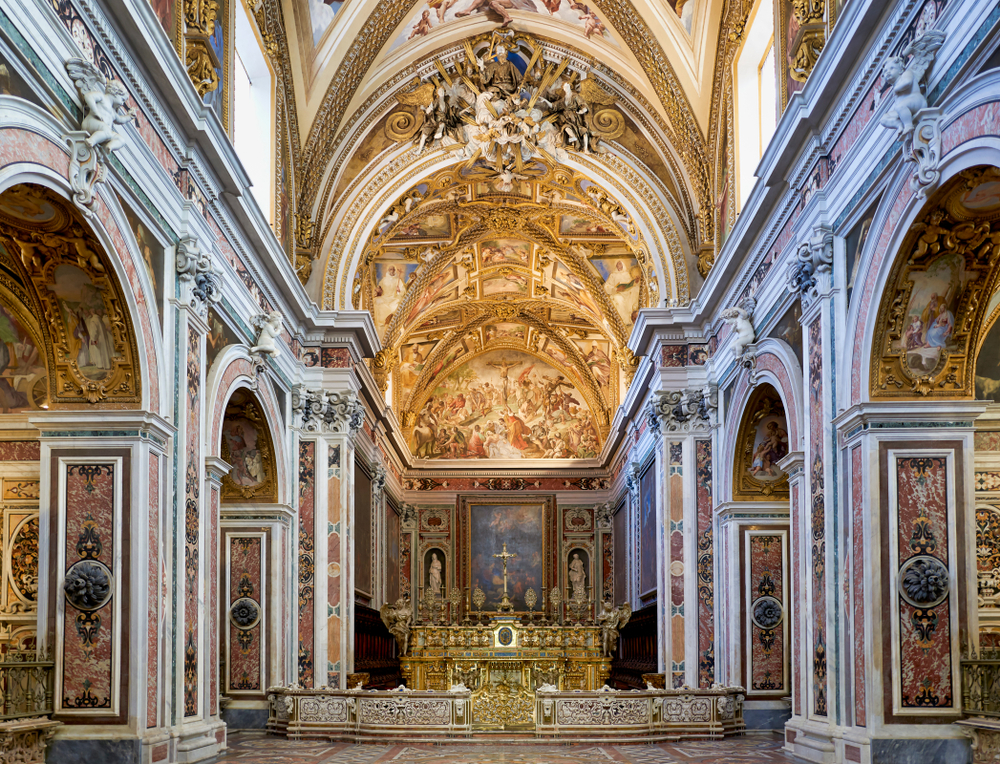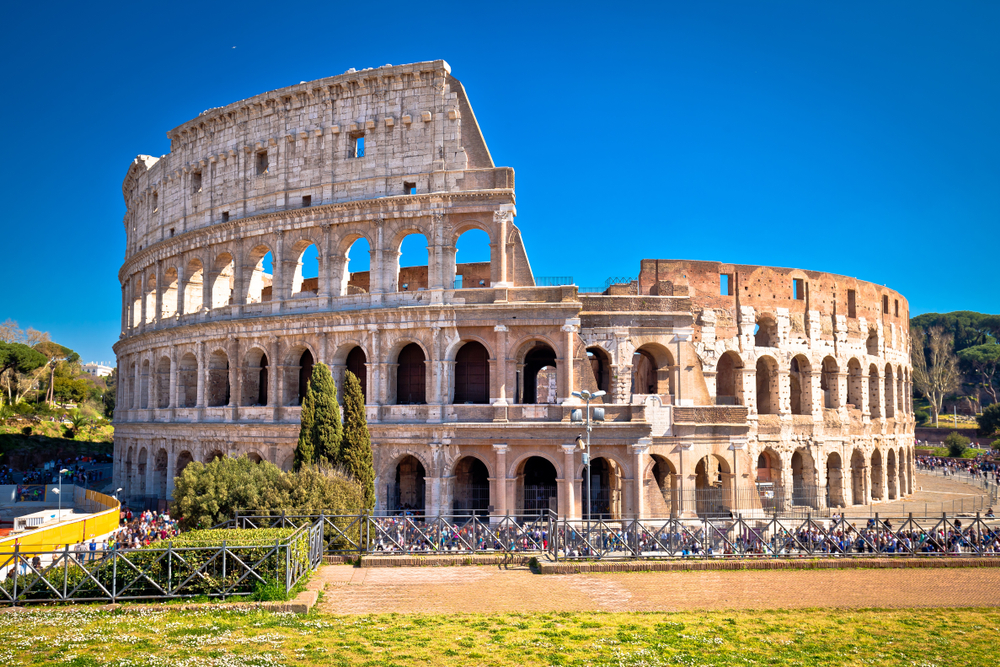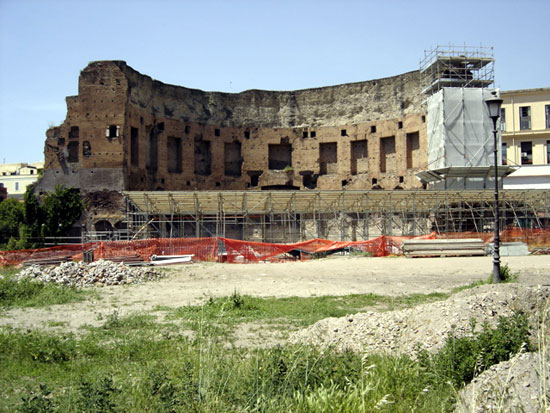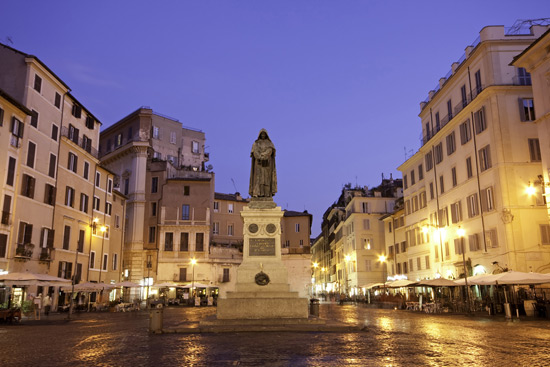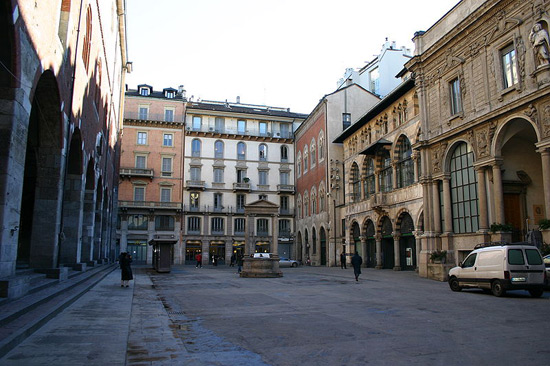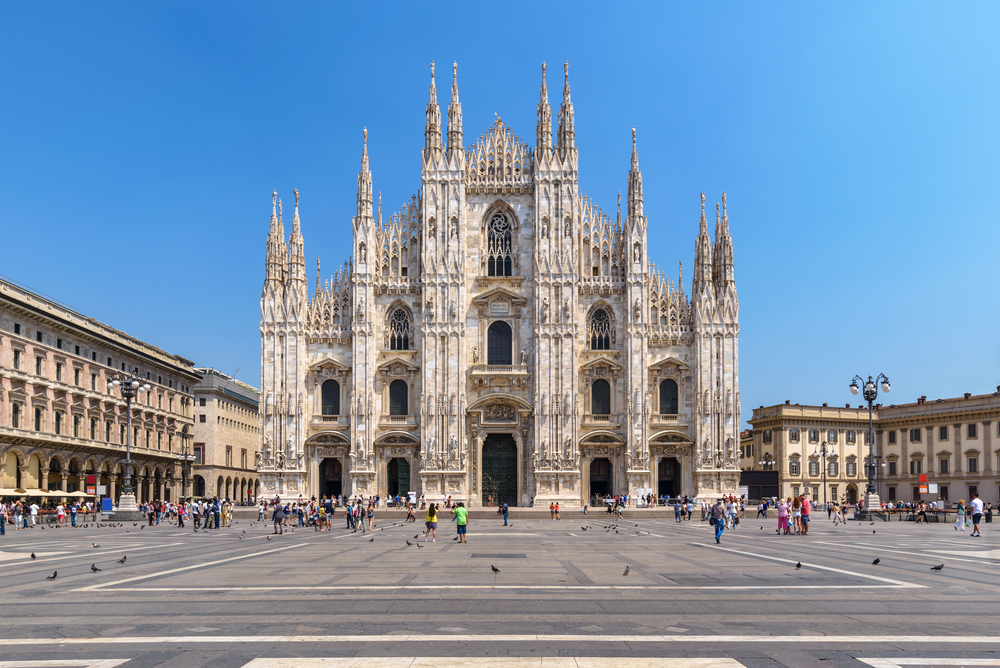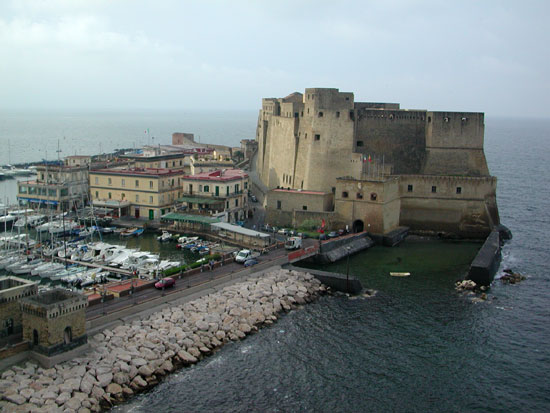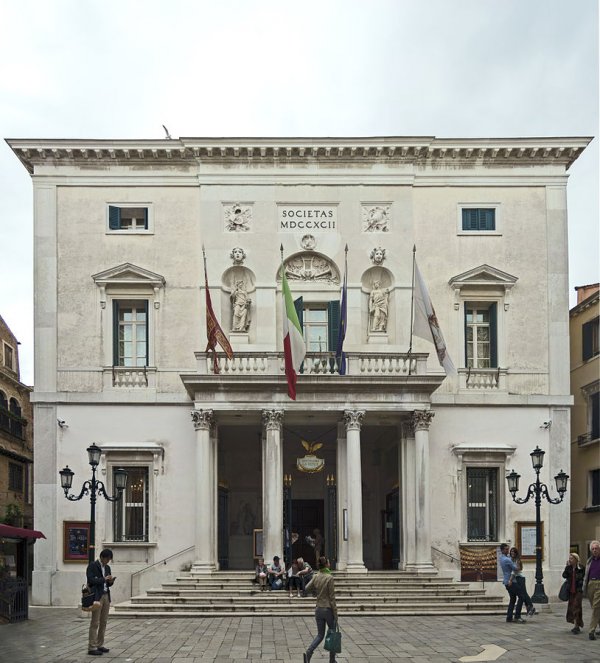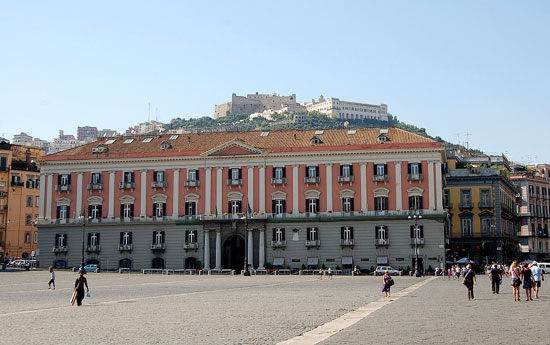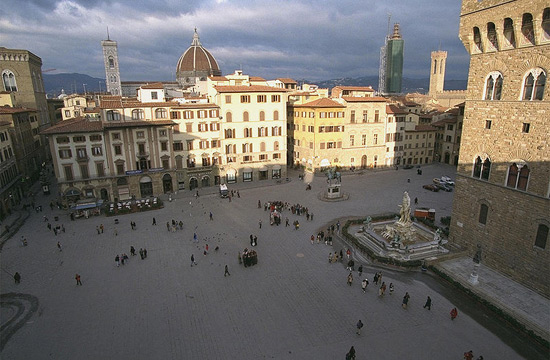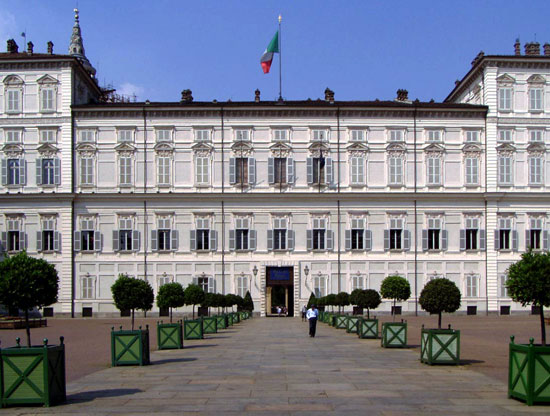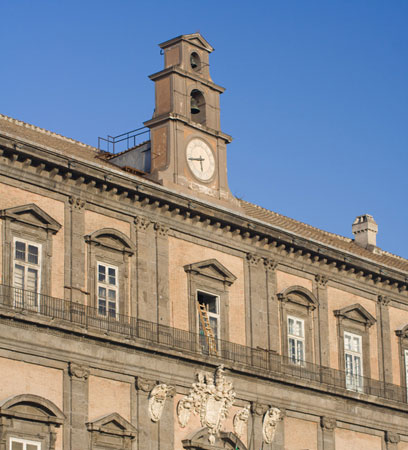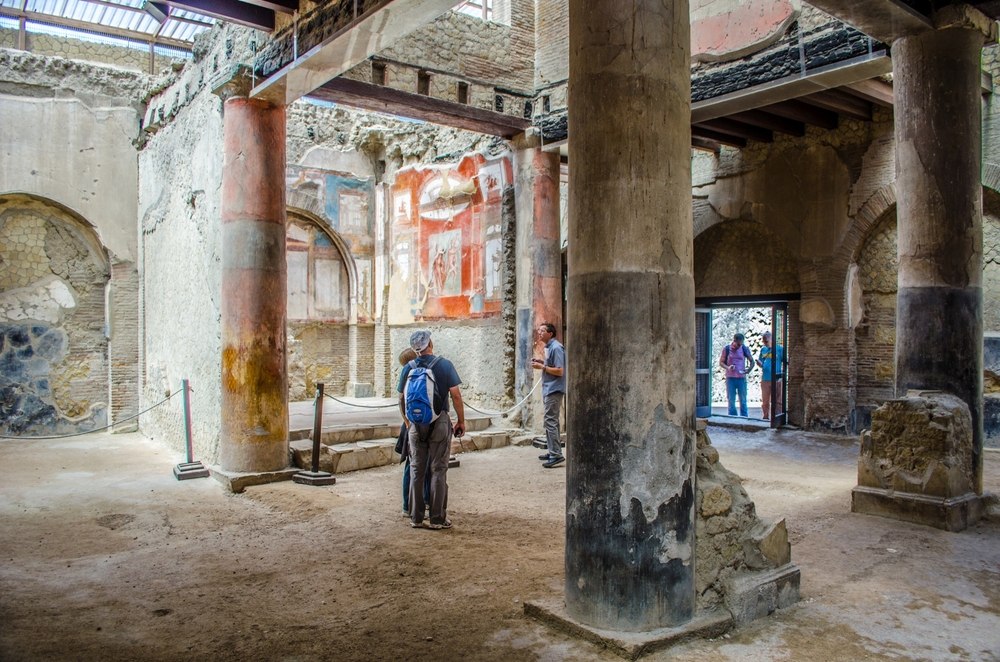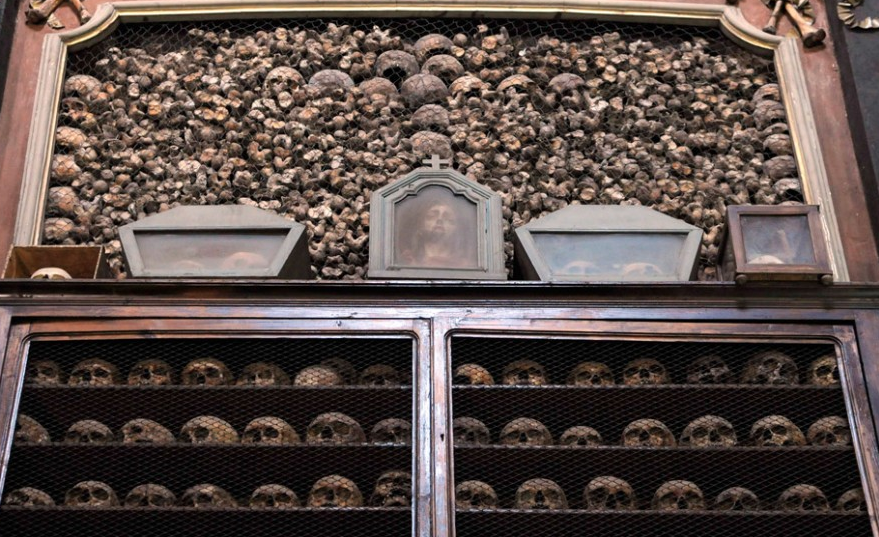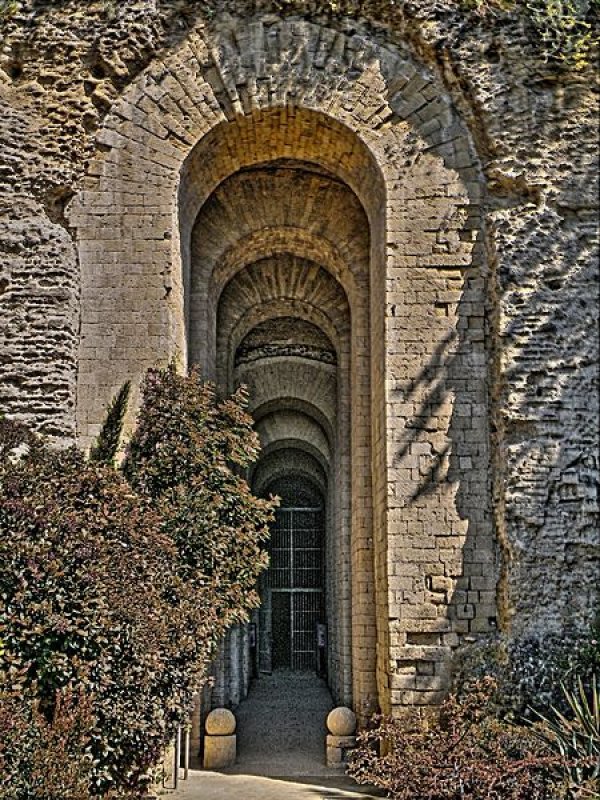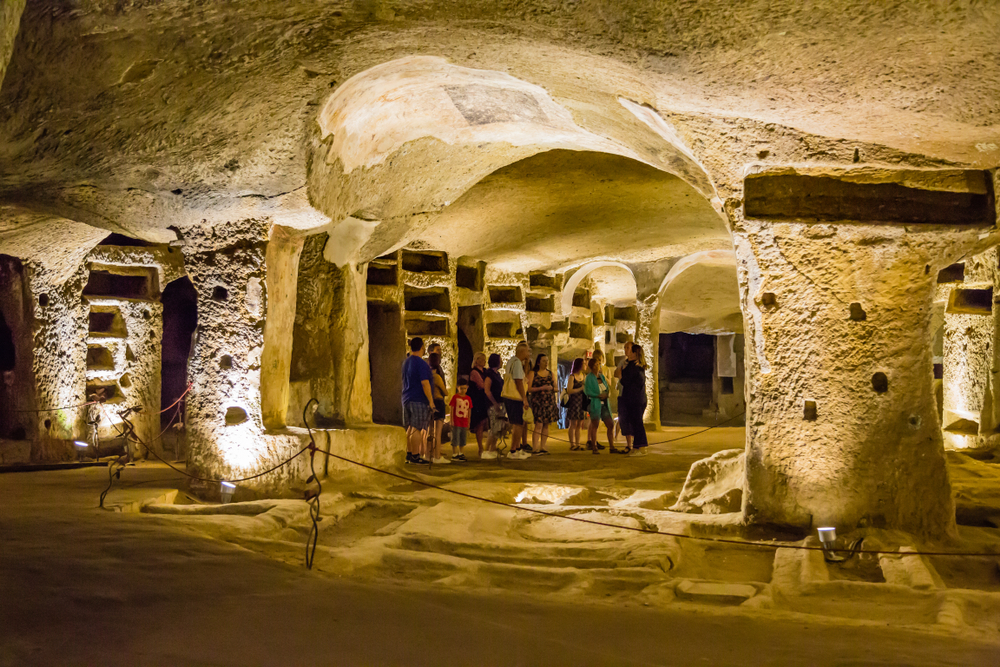Points of Interest
Capuchin Crypt
Cripta Cappuccini Santa Maria della Concezione dei Cappuccini Via Veneto 27
Rome 00187, Italy
Rome is crisscrossed with catacombs—underground ossuaries, filled with centuries worth of human bones. Some of these remains were once priests or parishioners, some were paupers, and others were removed from cemetery grounds given over to development. Of all the catacombs, perhaps none are as macabre as those beneath Santa Maria della Concezione. The church was completed in 1631, and administered by the Capuchin Friars, a Franciscan order that took vows of poverty and begged barefooted for their meals. It's a relatively small and undistinguished church; most visitors come for the catacombs beneath. Here, the bones of more than 3,500 people have been arranged into the shape of crosses and other religious symbols, used to decorate numerous underground chapels. There are chapel archways and altars made entirely of human skulls, and skeletons dressed in monks' robes for statues. It is a strange, eerie place, needless to say.
Castle of Rivoli Museum of Contemporary Art
Piazza Mafalda di Savoia Rivoli
Turin, Italy
This former royal residence of the House of Savoy is now one of Europe's foremost contemporary art spaces. The history surrounding the castle, from the negotiations surrounding medieval accession to the house arrest of Victor Amadeus II (at least until he had produced a male heir), lend the collection an aspect of historical permanence, even though the museum was only established in 1984. The roll call of artists is as impressive as Castello di Rivoli's aristocratic pedigree. Consider these names from the international art scene, featuring some of the most influential painters, photographers, and sculptors from the last 60 years: from America, Sol LeWitt, Nan Goldin, and Dan Graham; from Britain, Tracey Emin, Gilbert & George, and Tacita Dean; Germans Andreas Gursky, Thomas Struth, and Anselm Kiefer; Italian Francesco Clemente; Canadian Frank Gehry, Dutchman Jan Dibbets, Dane Olafur Eliasson, and South African William Kentridge.
Catacombs of San Gennaro
Catacombe di San Gennaro 13 Via Capodimonte
Naples 80136, Italy
Naples has its share of dark sites, and this is one of the best. Although surely not as spooky as they would have seemed in the early part of the Common Era, when Neapolitans began burying their dead here (or as terrifying as the nameless Italian catacombs where Edgar Allen Poe's character in "The Cask of Amontillado" is left to die), the catacombs' two-story subterranean cemetery houses 10 centuries of bodies, and has been otherwise used by Italians for another thousand years. The catacombs date back to the 2nd century, and the frescos and mosaics here represent the earliest days of Christian life and death. St. Agrippino, the 3rd-century bishop of Naples, is buried here, and the tomb of Naples' patron saint, San Gennaro, is here, although his remains were relocated to the Duomo. Entry by guided tour only. Call to schedule an English-speaking tour.
Catania University
Piazza dell'Università
Sicily, Catania 95131, Italy
Alfonso V of Aragon founded Sicily's oldest university in 1434, though it took several decades to organize the first few faculties. While the earthquake of 1693 wreaked havoc on the academic institution, it also gave the college an opportunity to construct a purpose-built structure, rather than continuing to use the former hospital of St. Mark's. As the students toiled in wooden huts beside the harbor, Palermo architect Giovanni Battista Vaccarini conjured a baroque vision in three-story stone. Look for the textured rusticated surfaces in the 1752 building, alongside the lava masonry, and the liberated use of human sculptural detailing in the putti. The university is located centrally on Via Etnea, just a stone's throw from the cathedral, making it easily accessible for visitors looking to see Vaccarini's work, the tiled courtyards, the cool cloisters, and the florid Basilica della Collegiata.
Cathedral of Santa Maria del Fiore
Duomo 1 Via della Canonica
50122 Florence, Italy
Too famous and majestic to miss, the construction of the Cathedral of Santa Maria del Fiore began in 1296. Designed in Gothic style, this is the third-largest church in the world, after Rome’s St. Peter’s Basilica and London’s St. Paul’s Cathedral. The nickname of Duomo derives from the enormous octagonal dome on the east end, while the structure itself is 153 meters (502 feet) long, 90 m (295 ft) wide at the crossing, and 90 m (295 ft) tall. Visitors will enjoy learning interesting facts, like how the dome remains the largest brick and masonry dome ever built and how skeptics thought it would collapse.
Today, the Duomo is recognized around the world as a symbol of both Florence and the Renaissance. There are ceiling and wall frescoes, detailed mosaics, and stained-glass windows by artists such as Vasari, Zuccari, Donatello, and Ghiberti. Also inside is the New Sacristy, where early Italian Renaissance statesman Lorenzo de' Medici took shelter in 1478 after he and his brother Giuliano were attacked (Giuliano was killed) while attending Mass. The views from atop the cupola are incredible, reached only after climbing 463 winding steps, which may be too much for little kids but prove a good challenge to older ones.
Cathedral of St. John the Baptist
Duomo di San Giovanni Battista Via XX Settembre 87 Piazza San Giovanni
Turin, Italy
It has been Turin's most celebrated icon for centuries: Sacra Sindone (the Holy Shroud), an enigma in linen. Thought to be the cloth that wrapped the crucified body of Christ, this length of linen has been debated and discussed virulently for hundreds of years. Even after the Catholic Church agreed to sophisticated carbon dating in the 1990s, the genesis of the shroud was not completely clear. Due to the relic's age, it is only shown every quarter of a century, though there is a permanent replica on display in front of the altar of this 15th-century cathedral (plus a museum, the Museo della Sindone, on nearby Via San Domenico). Outside this Renaissance structure designed by Meo del Caprina, look out for Turin's Roman remains, the old Porta Palatina gate, flanked by two towers.
Charterhouse of St. Martin
Certosa e Museo di San Martino 5 Largo San Martino
80129 Naples, Italy
There is much to see and admire at this former monastery, from its museum full of artifacts and the hanging gardens, to the view from its Vomero hilltop setting. Take the funicular at Montesanto station to get here then wander the grounds and admire the chapel’s intricate exterior. Inside are the painted ceilings and marble alters that amount to what some say is the most beautiful church in the city. Kids will see boats, model ships, swords, pistols, and much more in the museum. Adults will appreciate the 17th-century paintings and collection of presepi (nativity scenes). The views from outside offer all of Naples below, including Mount Vesuvius and the Gulf of Naples. Once you’ve taken your share of outstanding photos, wander the Vomero neighborhood and shop, grab a bite to eat, and finish off with some gelato.
Colosseum
Colosseo 1 Piazza del Colosseo Rome
00184 Lazio, Italy
One of the most famous monuments of the Roman Empire and an iconic symbol of Rome, the Colosseum is a huge amphitheater that measures over 49 meters (160 feet) in height and has a seating capacity of 50,000. Inaugurated in 80 CE, the Colosseum was the center of all public entertainment, including gladiatorial games, animal hunts, executions, mock battles, and dramas, until the 6th century. It eventually fell out of use during the early medieval era. Over the years, the Colosseum was used as a fortress, quarry, Christian shrine, and quarters for a religious order. The Colosseum has close ties with the Roman Catholic Church and hosts the annual Good Friday "Way of the Cross" procession.
Doge's Palace
Palazzo Ducale 1 San Marco Venice
30124 Veneto, Italy
Doge's Palace is a Gothic-style palace constructed from 1309 to 1424, although its foundations are thought to date back to the 9th century. The palace, the official residence of the Doge (Chief Magistrate) of Venice, houses lawyers' offices, office of the Chancellery, office of the Censors, naval offices, the Grand Council Chamber, and the Ballot Chamber, spread over the first and second floors. The third floor is decorated with paintings, including those of previous Doges, and usually reserved for hosting foreign ambassadors. Tintoretto's Vast Paradise, the world's largest painting on canvas, can also be seen in the Grand Council Chamber.
Domus Aurea
Viale della Domus Aurea 1
Rome 00184, Italy
Everyone knows the story of how Nero fiddled while Rome burned. Less well known is that once the fire was put out, he cleared much of the burned out Esquiline Hill to construct his Domus Aurea, or House of Gold. This enormous estate, Domus Aurea covers more than 100 acres. It features grand reception halls, dining rooms, and sleeping chambers for hundreds of guests. The grounds of the estate include formal gardens and Colosseum. Nero enjoyed his pleasure palace for only a few years before dying in 68 CE. Buried and forgotten for centuries, it was rediscovered during the Renaissance.
Field of Flowers Square
Piazza Campo de' Fiori Rome, Italy
Campo de' Fiori means "field of flowers," and was likely a literal description originally, as this part of Rome was largely undeveloped until the late 1300s. Today Piazza Campo dei Fiori is home to a busy morning market selling flowers, produce, cheese, and fresh meats. After sundown the local bars overflow into the square, which stays noisy and crowded till the early hours of the morning. Executions were held here, including that of Giordano Bruno, a former Dominican priest whose views on the nature of the universe led to his trial for blasphemy and heresy. Unlike Galileo, he refused to recant, and was burned at the stake in 1600. A dark statue of Bruno stands in the square today, brooding grimly over the happy shoppers and vendors.
Historic Center of Florence
Central Florence, Italy
Florence’s compact and historic city center has much to offer families visiting the city. Kids will get a sense of history just from the cobblestoned streets and there’s scenery aplenty along the Ponte Vecchio, a medieval stone arch bridge. The area is a UNESCO World Heritage Site, full of piazzas (public squares) and distinct architecture of Renaissance-style palaces and churches. Some of the city’s major art museums are found here, including the Uffizi Gallery and Pitti Palace. Street musicians are a common sight within the city center, providing entertainment for the whole family while you enjoy yet another cup of creamy gelato. If you’re accompanied by little travelers, be sure to let them ride the antique carousel.
Historic Center of Rome
Rome, Italy
Believed to have been founded in 753 BCE, Rome was the center of the Roman Republic and the Roman Empire, and it was acclaimed as the center of the Christian world by the 4th century. Some important monuments of ancient Rome include the Colosseum (the largest amphitheater of the Roman Empire), Roman Forum, Pantheon, Catacombs of Rome, and the Pyramid of Cestius. Equally famous are the vast and regal squares and the obelisks (shafts of stone with a tapering end on one side) built in the 17th century. The old city has about 200 palaces, 900 churches, 300 hotels, eight major parks, the president's official residence, offices of the government, and innumerable well-known monuments.
Imperial Forum
Fori Imperiali Via dei Fori Imperiali
Rome, Italy
The Imperial Forum is a collective unit of the forums of Trajan, Augustus, Nerva, and Caesar. Julius Caesar built the additional forum to ease overcrowding in the Roman Forum. It became Rome's first shopping district, complete with liquor stores, fast food outlets, and Trajan's Market, a surprisingly modern two-story mall with stores selling wine, groceries, flowers and household necessities. Much of the Imperial Forums has been lost over time. Some ancient structures were recycled for new building materials, and others were plowed under when Mussolini built the Via del Fori Imperiali. This broad avenue runs from Piazza Venezia to the Colosseum, and ironically, takes its name from the forum it partially destroyed. The buildings and temples that remain are remarkably intact, more so than most of those in the Roman Forum. The Museum of the Imperial Forum is located in Trajan's Market and offers tours of the market and forum grounds.
Merchants Square
Piazza Mercanti Piazza dei Mercanti
Milan 20100, Italy
This square is a must-visit for anyone who wants a taste of Milan's early-medieval, pre-Renaissance history. In a city that has been so overdeveloped as well as damaged by war, it is refreshing to stroll past the grand Town Hall (Palazzo della Ragione) and its open arcade, originally built in 1233. Opposite this is the black-and-white marble Palazzo degli Osii (1316) and its coats of arms and statues pertaining to the square's role as the commercial and administrative center of the city. It was from the loggia (balcony) that official edicts or important news would be read to the Milanese public. The Palazzo stands adjacent to a smaller, very quiet square that is home to many secondhand booksellers.
Milan Cathedral
Duomo di Milano Piazza del Duomo
20122 Milan, Italy
Whether you simply tell the kids, “They don’t make ‘em like that anymore,” or that the construction of the Milan Cathedral began in 1386 and took nearly 600 years to complete, this beautiful sight should impress the whole family. The cathedral, called the Duomo, played a significant role in spreading the Christian faith and establishing Catholic traditions of worship. Measuring 157 meters (515 feet) long, 92 m (302 ft) wide, and more than 106 m (350 ft) high, the 40,000-seat capacity Milan Cathedral is the second-largest church in Italy (next to St. Peter's Basilica) and the second-largest Gothic cathedral in the world (after the Cathedral of Seville in Spain). The cathedral's numerous monuments and artworks include three superb altars, the St. Bartholomew statue by Marco D'Agrate, the tombs and sarcophagi of many archbishops, and other architectural masterpieces. Guided tours are available, and rooftop views of Milan are worth the small fee.
Monumental Complex of St. Clare
Complesso Monumentale di Santa Chiara Via S. Chiara 49
Naples 80134, Italy
Standing tall, stark, and intimidating, this Gothic building dates back to 1310 and is one of the city's oldest and most revered religious symbols. During the baroque revolution in the early 1700s, the building got a robust makeover, and its cloister (Chiostre della Clarisse) was furnished with the now-signature Neapolitan blue, green, and yellow majolica tiles that reflect the landscape of sky, grass, and lemon tree. Sadly, Allied forces hit the church and cloister during World War II, resulting in a major loss of the original Gothic features. However, since its restoration over the last century, the basilica and cloister have been restored to their former glory, and the complex houses museum rooms dedicated to the structure's long history, the site's archaeological findings, nativity scenes (presepi), marble, ruins, and reliquaries.
Naples Underground
Napoli Sotterranea 68 Piazza San Gaetano
Naples, Italy
Hidden beneath Naples a 450-kilometer (280-mile) network of underground caves and tunnels built in 4th century BC by the Greeks who called it Neapolis, meaning “New City.” Later the Romans would use the pathways to build aqueducts, which provided water for many centuries. The subterranean Italian city is accessed by a long staircase that leads down 40 meters (120 feet) to a maze of caverns, catacombs, aqueducts, sewer tunnels, rainwater cisterns, railway tunnels, roadway passages, and the ruins of a Greco-Roman theater. Used as an air raid shelter during World War II, the site includes forgotten war relics such as weapons and vehicles. Today, Naples Underground also includes an experimental garden.
Navona Square
Piazza Navona Between Via di Santa Maria dell'Anima and Corso del Rinascimento
Rome 00186, Italy
Piazza Navona is Rome's most inviting and engaging square. More of an elongated rectangle than a square, the piazza grew around the ruins of an ancient racecourse. The curve of the track can be traced in the rounded northern end of the square. Apart from the Church of St. Agnes of Agone, the buildings surrounding the square are equal (or nearly so) in height, giving the piazza a harmonious appearance. Several cafés and restaurants with sidewalk seating are dotted throughout. This is a great place to relax, have lunch or a glass of wine, and practice your Italian with local residents. The piazza also hosts art shows, live music, and a variety of open-air markets, including a wonderful Christmas toy market in December.
Ovo Castle
3 Via Eldorado
Naples 80132, Italy
Legend has it that Virgil placed an egg beneath this Naples fortress to protect it—hence its name, the Castle of the Egg. Located at the spot upon which Naples' history began in the 9th century BCE, this iconic castle jutting out from the seashore is a hotbed of history. Its prehistoric location and classic poet's affiliation aside, the fortress stood strong through the Middle Ages and functioned as a royal residence until the 1900s. Now it fittingly houses the Museum of Ethno-Prehistory, which is open for special exhibits. Check out the stunning views, and then head to Borgo dei Marinari for seafood.
Palatine Hill
Palatino Collis Palatium West of the Colosseum
Rome 00186, Italy
Stone Age artifacts unearthed in the Palatine Hill are testament to the existence of prehistoric settlement in the area eons before Rome was founded. The Palatine Hill area is famous as the location of the cave in which the twins Romulus and Remus, legendary founders of the Eternal City, were nursed by a wolf. In ancient Roman times, this was a place for the ostentatious palaces of emperors, the Beverly Hills of its time. The sprawling ruins that remain give some idea of the size of these estates. The long-lost House of Augustus was discovered 50 years ago, and several rooms, adorned with exquisite frescoes, were recently opened to the public. The museum offers guided tours.
Phoenix Theater
Teatro la Fenice 1965 Campo San Fantin
30124 Venice, Italy
Teatro La Fenice, located in Venice and inaugurated in 1774, has been home to many famous operatic premieres. Famous Italian composers like Bellini, Rossini, and Guiseppe Verdi premiered many of their productions at this theater. The theater was twice razed by fire and once lost in a legal battle involving the owners and the theater management. Reconstructed in 1790, 1837, and 2001, the current structure was built with the help of old photographs to resemble the original 19th-century style.
Piazza Plebiscito
Piazza del Plebiscito
80132 Naples, Italy
A large public square, Piazza Plebiscito is a gathering spot for Naples’ residents, where they come to stroll, chat, and let the kids play. The expansive open space includes some of the city’s major monuments and architecture, including the royal palace, the domed Basilica of San Francesco da Paola, and the pastel-colored Palazzo della Prefettura and Palazzo Salerno, one located on each side of the piazza. Enclosed by a curving row of columns, the scenic area conveys the city’s grandeur and includes bronze equestrian statues that will make for fun photos of the kids. Various concerts and events are held here throughout the year or just wander through the narrow streets and people watch. Before you leave the area, stop by the historic Gran Caffe Gambrinus in the corner to grab some coffee and pastries, or stay to admire this coffeehouse that was a haven for the city’s residents, intellectuals, and politicians, dating to 1860 and including decorative ceilings.
Platform 16 Holocaust Deportation Memorial
Piazza della Stazione
Florence, Italy
There are two memorials at the Santa Maria Novella train station, one to Florentine Jews and the other to Italians who were deported to concentration camps during World War II. Of the 243 Jews who were sent away, only 13 returned. The station’s largest memorial, located at platform 16, is in their honor. It is a symbolic depiction of a railway track blocked by a large stone block that appears to be split into pieces by a giant metal spike. The station’s other memorial is a modest plaque to 338 Italian men who also were deported to concentration camps, with only 64 returning. Italy became a divided country during WWII, with the south switching sides to defy Nazism and side with the Allied forces, while the north became the Social Republic of Italy under fascist control. The deported men were arrested for questioning, along with women who were later released, by fascist forces looking for information about an earlier strike in their territory that had been called by the National Liberation Committee. The location of these memorials recognizes that the train station was the victims’ place of departure as well as their last sight of Florence.
Plaza of the Signoria
Piazza della Signoria Florence, Italy
The square contains a nice selection of statuary, including Giambologna's equestrian statue of Grand Duke Cosimo I and replicas of Michelangelo's David and Donatello's Marzocco. There also is a long raised platform that fronts the Palazzo Vecchio. This is known as an arringheria (oration platform); from such a platform speakers would address the crowds that gathered in times of political unrest. The English word harangue is derived from this speakers' spot.
Roman Forum
Foro Romano 5/6 Via della Salaria Vecchia
Rome, Italy
The Roman Forum was the center of political, judicial, and social activity during the Roman Empire. Numerous monuments, temples, basilicas, shrines, royal residences, and headquarters were contained within the Forum. Some of the major monuments in the Forum are the Temple of Romulus, Temple of Saturn, Temple of Vesta, Temple of Venus and Roma, Basilica Aemilia, Basilica Julia, and Regia, the residence of the kings of Rome, which later became the office of the high priest of Roman religion. Although the Forum went into a state of disuse with the fall of the Roman Empire, archaeologists have unearthed many architectural riches there.
Royal Palace
Palazzo Reale Piazzetta Reale 1
Turin, Italy
The exterior of this regal palace (created by the Count of Castellamonte) is sturdy, even stolid, an austere entrance to something far fancier. Only when visitors go inside does the palace's baroque lineage become clear, with room after room of monumental artworks. Climb the impressive staircase (designed by Domenico Ferri), wander around the cavernous Salone degli Svizzeri and admire the friezes by the brothers Fea, or marvel at the sculptures of the Throne Room. The sheer scale of the place and the amount of patronage on show illustrates how the royal House of Savoy could keep a city of artisans working over three centuries. Almost forgotten outside are the Royal Gardens, laid out in 1697 by André le Nôtre. And don't miss the Armeria Reale (Royal Armory), with its collection of inlaid weapons, 16th-century armor, and Japanese battle masks.
Royal Palace of Naples
Palazzo Reale 1 Piazza del Plebiscito
Naples 80132, Italy
Commissioned in 1600 and finally finished in 1843, this sprawling palace stands for the opulence of the Bourbon rulers. Now a museum and a testimonial to Naples' vibrant history, the palace has 30 rooms open for tours, each one more extravagant than the next. Visit the throne room, the king's study (which holds a desk and other furniture made for Napoleon), and marvel at the multitude of rooms that display marble, gems, gold, and artwork by such masters as Giordano and Vaccaro. The Royal Palace also houses the National Library, one of Italy's finest institutions, which contains approximately 1.5 million printed volumes and 1,800 Herculaneum papyri.
Ruins Tours
Pompeii or Herculaneum Ruins
Milan, Italy
All you need to do to travel back in time is drive about 24 kilometers (15 miles) from Naples, where you’ll end up at the ancient, ruined city of Pompeii. You know the one—destroyed by hot gas and lava that erupted from nearby Mount Vesuvius in 79 CE. An experience that will transcend any schoolbook learning, a visit is sure to create lasting memories. In addition, there are the ruins of Herculaneum to consider, also close by, at just 15 minutes from Naples. These excavated cities include many streets, houses, villas, baths, and temples that are still standing. The sight of all this will bring life in the 1st century to the forefront of the imagination, giving kids a glimpse of what Roman cities looked like nearly 2,000 years ago. You can reach both cities by trains that leave from central Naples.
Sacred Doors Cemetery
Cimitero delle Porte Sante 34 Via delle Porte Sante
Florence, Italy
Cemeteries may not be the first place you think to visit when wishing to view sculptures, yet this Florence cemetery is notable for its funerary art. It also is the final resting place for several famous Florentines including writers and artists, among them the creator of Pinocchio, Carlo Collodi. Located behind the 1,000-year-old church of San Miniato al Monte, the cemetery is reached after ascending to the hilltop location that offers stunning views of Florence. This is just an added bonus, as the sights within the cemetery include larger than life statues of angels, 19th century designs and symbols, allegorical figures, and female figures with gracefully draping clothes that defy their stone origins. Among the many realistic portrayals is the monument to the Mazzone siblings, Mario and Maria, a touching tribute from a mother to her two grown children, whom she wished to remain together eternally. Mario was a fighter pilot killed in World War II, and Maria died a year later, just days before her wedding. The siblings are rendered as full size, smiling statues who face each other, he in uniform and she in a wedding dress. Many of the cemetery’s chapels replicate Florentine churches, having neo-gothic and neo-renaissance designs. Whether you come for the art, history, views, or to recall the contributions of famous Florentines, the experience is sure to leave a lasting impression.
San Bernardino alle Ossa
Via Brolo
Milan, italy
It may prove difficult not to ponder Milan’s history when faced with the skulls and bones kept within the San Bernardino alle Ossa. The church includes an ossuary, a room where the bones of dead people reside. The bones are not kept hidden away in a box but are on full display, arranged in patterns and rows and fronting whole sections of wall as well as doors and pillars. It is believed that most of the bones came from a nearby hospital and its graveyard designated for deceased patients, though space ran out and a small chamber was built in 1210 to house the bones. When the San Bernardino alle Ossa was built in 1269, the bones were moved into a room near the church’s entrance, which also became the final resting place for bones from other graveyards. If you’re not one to be creeped out by rows of skulls and stacks of human bones, then plan a visit to San Bernardino alle Ossa. The centerpiece is a huge cross made of skulls.
Seiano Grotto
Grotta di Seiano Naples, Italy
The grotto part of this title is a misnomer: rather than a cave, the Grotta di Seiano is an ancient tunnel leading to a first-century Roman villa. Former slave and self-made man (and notoriously cruel) Pollio enjoyed the views from his royal residence, and upon his death he turned the estate over to none other than Caesar Augustus. The villa, amphitheater, and statues once part of this royal Roman estate are in ruins, but the tunnel was repaired by the Bourbons and remains in good shape today. A park, Parco Archeologico-Ambientale del Pausilypon, was created around the site. It also contains a visitors' center and an underwater park.
Underground Naples
Napoli Sotterranea Beneath the Historic City Center
Naples, Italy
No one in the family is likely to forget the unique experience you’ll get under the streets of the city center. Napoli Sotterranea (Underground Naples) is found 40 meters (120 feet) below ground, including aqueducts, secret chambers, catacombs, and even vegetable gardens. Their construction began over 2,000 years ago, and the area was used as an air-raid shelter during World War II. Your tweens and teens may be most excited to explore here, though little ones may find it spooky. Touring the area, with its hidden labyrinth of tunnels and passageways, gives a glimpse into an ancient way of life. Some areas are optional, as tunnels are extremely narrow and require use of a candle to see by. Guided tours are the only way to visit here, which last about 90 minutes.
Venetian Arsenal
Arsenale di Venezia Central Castello
Venice, Italy
The Arsenal is the power behind Venice's Gothic glory. At its 16th-century peak, this shipbuilding yard could produce a vessel every day. When Venice faced a threat from the Turks in 1597, the 16,000 men of the Arsenal churned out 100 warships in only 60 days. Though visitors have long been dazzled by the city's paintings and palazzos, this is the real source of its strength. Still an Italian naval base, the Arsenal contains a museum filled with rigging and relics from Venice's maritime heritage. Among the models of warships, a collection of 24 Chinese junks, and displays of fishing vessels, is the Bucintoro, the magnificent galley used annually on the Day of Ascension when the doge would symbolically wed Venice to the sea. Look out for the Piraeus Lion, a Greek-made stone sculpture etched with runes from Scandinavian mercenaries.
Copyright © 1993—2025 World Trade Press. All rights reserved.

 Italy
Italy 
